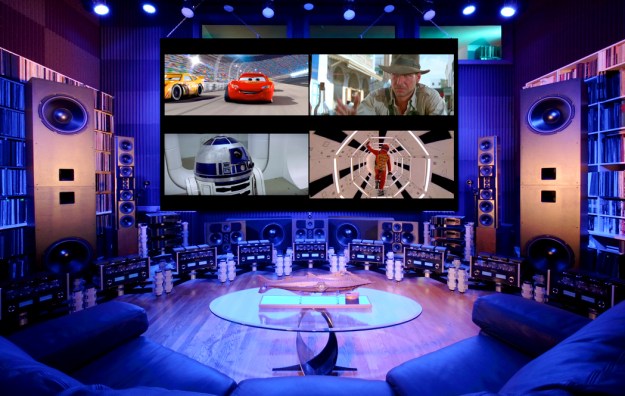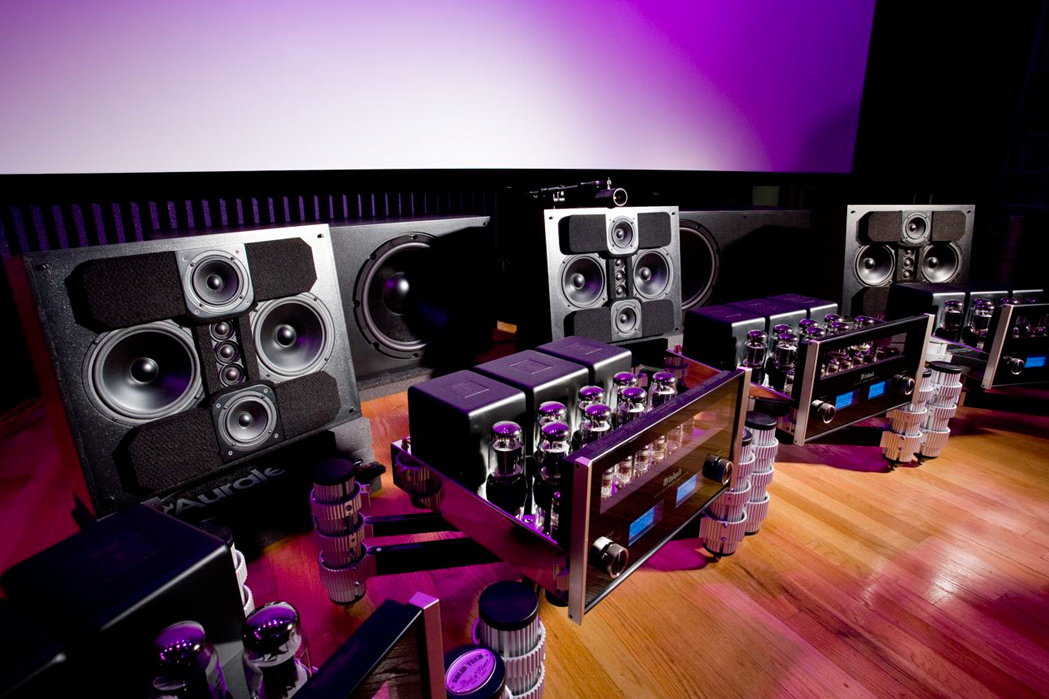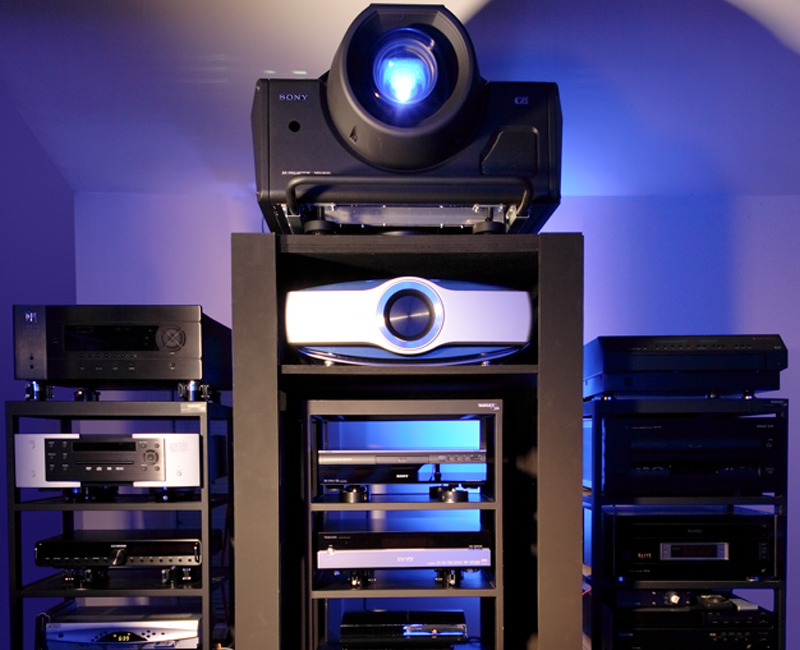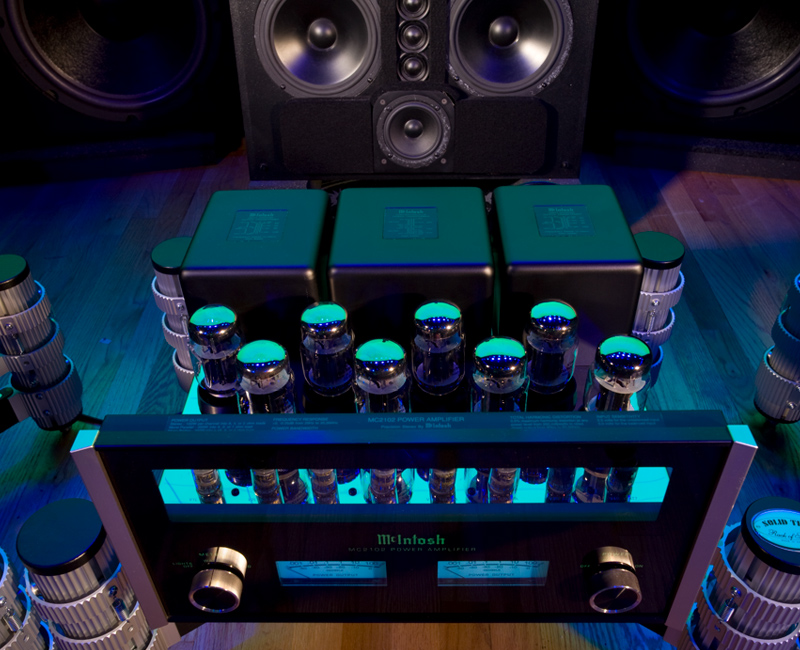
There probably isn’t a limit to what can be spent in pursuit of building the ultimate home theater system, but that hasn’t stopped some people from making an honest go at finding one. Over our many years of involvement with the home theater industry, we’ve been fortunate enough to see some pretty elaborate setups, some coming in for as much as $1 million once design fees, construction, supplies and equipment are factored in. But $1 million is chump change compared to the cost of the theater Jeremy Kipnis built on his property in Connecticut. Get ready to check out the most bad-ass home theater on the planet.
From our perspective, any home theater that can recreate the movie theater experience in such a way that you forget you’re only footsteps away from your bedroom is both remarkable and worth the expenditure if you can swing it. The issue for most people – aside from financial constraints – is the lack of space needed to build something truly grand. Our homes are just not designed for anything approaching the size and scale of your local Cineplex.
Kipnis has an almost fanatical love of music and film that runs in his blood.
It would be easy to label Kipnis as just “some whacky rich guy” with too much time and money at his disposal, but that would be a mistake because he approached this project for all the right reasons. Kipnis has an almost fanatical love of music and film that runs in his blood. He has decades of professional experience as an engineer and design consultant, and an infectious desire to build systems that deliver an experience that can rival any of the grand venues that inspired him as a child.
According to Kipnis, who was raised in a home of professional musicians, the journey has been a “40-year quest to recreate his childhood experiences in venues like Radio City Music Hall” in both his home and those of his clients. Among those clients is Sean “P.Diddy” Combs, who hired Kipnis to design a six-room system for his NYC apartment.
But, arguably, Kipnis built the best for himself. “The room where we installed our Ciné Beta experience was originally designed for my father who used
it to practice, and hold concerts. It has no parallel surfaces, and was technically sound as a performance space,” explained Kipnis.

“The building is separate from my home and even has its own balcony, where people used to come and sit and listen to the musicians play. As a child, I got to experience a lot of wonderful music in a great acoustic environment, and that certainly influenced my decision to pursue a career as a recording engineer.”
Not surprisingly, Kipnis spun that passion into a career. He started as a recording engineer at Chesky in 1990, and owns his own record label, Epiphany Recordings. He has been writing about home audio and home theater for more than 30 years. Manufacturers such as Sony started using him as a beta-tester for its commercial-grade projectors, and he brings an almost encyclopedic level of knowledge to any discussion regarding music and movie reproduction.
His expertise includes large-format still photography (a student of Ansel Adams and Youssef Karsh), 3D 4K Cinematography and audiophile recording and engineering. His longtime love of cinema & television fueled the design and creation of the Kipnis Studio Standard (KSS) — The Ultimate Home Cinema, which he creates for select clients around the world. He is a six-year Guinness World Record winner for “Most Complex Home Theater & Video Gaming System” in the World (2008 – 2013).

Before you start counting your own media collection to see how it stacks up, spare yourself the disappointment and try to imagine the effort involved in accumulating 125,000 records, 16,000 LaserDiscs, 14,000 CDs, 12,000 DVDs, 10,000 reel-to-reel tapes, 9,000 cassette tapes, 8,000 HD-DVD and Blu-ray Discs, and more than 20,000 pieces of sheet music.
Kipnis’ Ciné Beta requires so much electrical power that he had to consult with Connecticut Light & Power to install two separate, external power transformers. The transformers sit on his own property, adjacent to the building housing the system.
According to Kipnis, the power issue “took more than a year and a lot of bureaucratic red tape and money” to sort out. 
So what do you get for $6 million?
Kipnis wouldn’t provide a more detailed breakdown, but the redesign of his space, electrical, acoustic treatment, and equipment ran close to 50 percent of the total cost. The theater sits on a half-meter-thick concrete foundation and requires a rather sophisticated HVAC system to keep it comfortable; especially with 72 tube amplifiers simultaneously emitting serious BTUs all the time.
At the heart of this IMAX-like experience is a professional-grade Sony SRX-T110 4K 3D projector that can reproduce 4096 x 2160P lines of resolution on a curved, 200-inch diagonal Stewart Snowmatte laboratory-grade unity gain screen, which was custom made for the system. Kipnis also uses a Meridian 810 Video Reference 4K 3-chip LCOS projection system that has a staggering ANSI rating of 4,000 lumens.
“The experience with video games, especially first-person shooters, is really quite extraordinary.”
“The video playback quality with both film, television, and video games is actually superior to what one would see in their local theater; albeit in a much smaller venue and sitting a lot closer to the screen creating an almost wraparound-like effect.
“The experience with video games, especially first-person shooters, is really quite extraordinary,” remarked Kipnis. “We had groups of teenagers come through when we first added gaming consoles to the system and they were blown away by the experience of playing games such as Gears of War, Call of Duty, and some of the better racing titles. Almost all of them experienced higher scores than what they usually achieved at home and they told us that the sensation of being in the middle of the action made them more aware of what was going on.”
“More than 4,000 people have come through our facility so far, including studio executives who wanted to see their content played back through our system,” Kipnis explained. “People think that this can only work for movies or video games and that’s wrong. Television programs are shot with some of the best cameras available and we’ve watched programs like Lost with the people from ABC and they were stunned by the quality.”
The system uses 16 sources; including Blu-ray, HD-DVD, LaserDisc, media servers, video game consoles, and a turntable for those 125,000 records we mentioned earlier.
For the audio end, Kipnis ordered 72 tube amplifiers from McIntosh (MC-2102 and MC-2301), which deliver 96,000 watts of power to a 12.12 surround sound system – the original configuration that Kipnis envisioned when he started planning the system.
Feeling that the 12.12 system was too much for the room, Kipnis scaled the system back to an 8.8 arrangement. He feels that, for most people, the scaled down speaker setup make mores sense from both a space and cost perspective. Kipnis has, however, reincorporated the extra channels back into his system as front height speakers. He suggests that they could be also be used above the listener to create something similar to Dolby Atmos for those clients that have enough room.
His choice of loudspeakers might surprise those who think that a system with a $6 million price tag must use the latest and greatest from such audiophile brands as Wilson or Magico. Instead, Kipnis assembled a collection of Snell THX Music and Cinema Reference loudspeakers that were originally designed for George Lucas and Tomlinson Holman.
The system consists of 12 full-range loudspeaker arrays and 12 subwoofers with a combined measured frequency range of 1 – 102,500 Hertz, and the ability to play both extremely loud (135 dB/SPL) and soft sounds (near 0 dB/SPL). The two possible configurations are set-up in a circle that surrounds the listening position, completely immersing the listener in the event.
It might be easy to assume that anyone spending $6 million on a home theater must be either a nutcase or a show-off. But design visionaries like Jeremy Kipnis are just trying to push the envelope to see just how close man can get to the ultimate home entertainment experience. Kipnis’ motivation is simply pure, unadulterated passion for music and film.
For those with the deep pockets required, Kipnis’ Studio Standard systems are as good as it gets right now.
For more from Jeremy Kipnis – including a closer look at some of the hardware he uses, his advice to those of us building on a smaller scale, and his plans for the future, read on for our Q&A with the home cinema master.Digital Trends: What inspired you to do this?
Jeremy Kipnis: Being raised in a house filled with professional musicians certainly had an impact. Both my grandfather and father were professional musicians, so when my father had the “building” designed so that he could put on live events in his own concert hall, it gave me the ideal space from which to start. Growing up in the New York-metropolitan area, we took in performances all over the place, but I was really fond of Radio City Music Hall. I suppose I always wanted to replicate that experience in my own home, and when I was able to do so, it was something that I devoted more than 42 months to.

As a student of all things film, video, and audio presentation, you can see some of my inspirations with several key views of theaters projecting onto a giant curved screen that were in existence from 1952 to 1968, preceding the IMAX Format. Believe it or not, 7.1 surround sound accompanied these wall-to-wall movies; shot and projected at resolutions and image sizes that were up to 20 times what we see today at the Cinema or on HDTV at home.
DT: But is the Ciné Beta really replicating Radio City in your home? The two spaces are completely different both in size and how they sound.
JK: It certainly isn’t possible for anyone to replicate that particular sound for a number of reasons, but what we’ve tried to do with Kipnis Studio Standard is create an image and sound experience that has no equal in the world; both in terms of image and sound quality.
Do you think you’ve succeeded or do you have to push the envelope even further based on technological advancements and what customers may want in their own homes?
We’ve never heard anything that compares to the Ciné Beta, but we also recognize that we need to offer far cheaper solutions for people, which is why most of my time involves consulting with people who want the hemispherical sound system and 4K image quality but on a much smaller scale. We have sold some of our most expensive systems to clients including the Ciné Beta that was most recently in our Connecticut space, but we’re not crazy enough to think that there is a huge market for seven-figure systems.
But what about a commercial version of your experience? Aside from the start-up costs, why couldn’t you offer a larger system in New York City for 400 to 500 people?
All along, my work at Kipnis Studios has been an ongoing project to produce the best picture and sound experience from media that is possible. My next project (after the TRINITY Ultimate Home Theater) is a much larger, commercial-sized CINEMA. It combines everything I have learned to create The MIRAGE Effect for an audience of 440 people. The 16K (4 x 4K Ultra HD) resolution I require for the 120-foot deeply curved screen can totally immerse the audience in one giant image or many smaller images (depending upon the show requirements – such as a video game tournament or live sporting event with many camera angles). I call this size version of my Kipnis Studio Standard (KSS) – the ALPHA Cinema (Ciné ALPHA); approx. $100 Million USD – to be built in New York City.
But what advice do you have for the average person who loves movies but obviously can’t afford a $6 million Kipnis Studio Standard system, let alone a $20,000 system?
My best advice would be to devote an equal percentage to each of the four components that are most important; power and source, loudspeakers, the display, and the room. People don’t realize how important the room is in the final result and spend nothing on acoustic treatments which is a big mistake. Spend some time moving your loudspeakers away from the walls or windows and do little things like add plants or change the direction of your blinds to break up reflections.
What about loudspeakers and the number of channels?
Consumers read publications and automatically think that by adding more channels to their specific room, the sound quality is going to improve. In the case of our Ciné Beta, it was designed to work that way. For 99 percent of the population, they need to start with two channels and build out. You need to think about the size of your room and how adding additional channels is going to interact with the space. It’s also important to keep everything at the same height for the most balanced sound.
What about new products like 3D, Ultra HD 4K, OLED, and surround formats like Dolby Atmos?
3D can be amazing if done properly, but it’s harder in the home where you are limited by screen size and because consumers hate the glasses. It’s a gimmick and people have already started to move onto Ultra HD 4K which offers a lot more in my opinion. OLED is a great concept, but I’m not convinced that it has much of a future if they can’t fix the production issues. The screens are really fragile and LG and Samsung can’t release a product that won’t be reliable. Dolby Atmos is a really exciting format that creates enormous possibilities in the home and I think it has a strong future.
Photography by Robert Wright / Copyright © Kipnis Studios 2013






